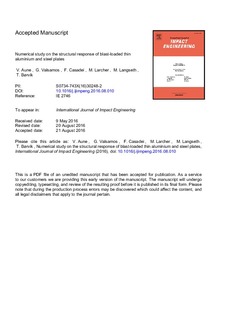Numerical study on the structural response of blast-loaded thin aluminium and steel plates
Journal article, Peer reviewed
Permanent lenke
http://hdl.handle.net/11250/2435081Utgivelsesdato
2016Metadata
Vis full innførselSamlinger
Originalversjon
International Journal of Impact Engineering. 2016, 99 131-144. 10.1016/j.ijimpeng.2016.08.010Sammendrag
The inelastic response of thin aluminium and steel plates subjected to airblast loading is studied numerically and validated against experimental data. Special focus is placed on the influence of elastic effects and negative phase on the structural response. The blast loading was varied by detonating spherical charges of plastic explosives at various stand-off distances relative to the centre point of the plates. The numerical results obtained with the finite element code EUROPLEXUS were in good agreement with the experiments and predicted the entire range of structural response from complete tearing at the supports to a more counter-intuitive behaviour (CIB) where the final configuration of the plate was in the opposite direction to the incident blast wave due to reversed snap buckling (RSB). RSB attracted special attention since this is an unstable configuration sensitive to small changes in the loading and in structural characteristics. The negative phase of the blast pressure is usually neglected in blast-resistant design. However, the numerical simulations showed that the negative overpressure dominated the structural response and led to RSB at some loading and structural conditions. Two distinctive types of CIB were identified and both were found to depend on the timing and magnitude of the peak negative overpressure relative to the dynamic response of the plates. The study also revealed that CIB may occur in thin plates when the negative impulse is of the same order of magnitude as the positive impulse. The partial and complete failure along the boundaries observed in some of the tests was also successfully recreated in the simulations by using an energy-based failure criterion and element erosion.
